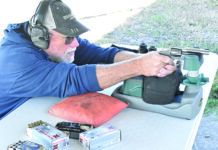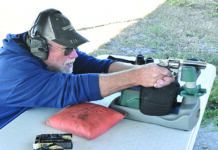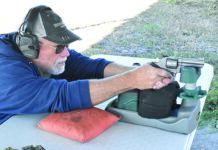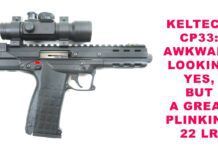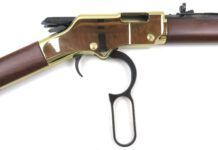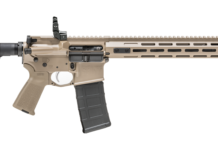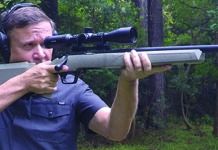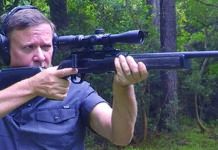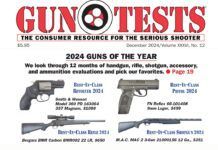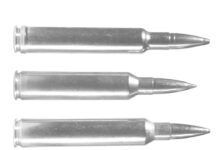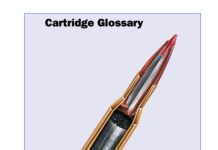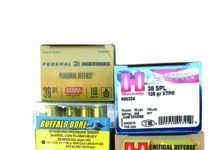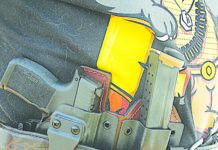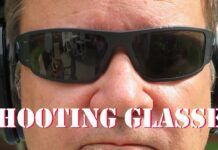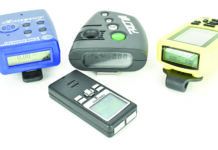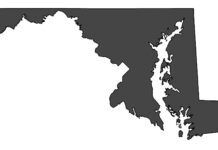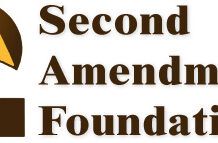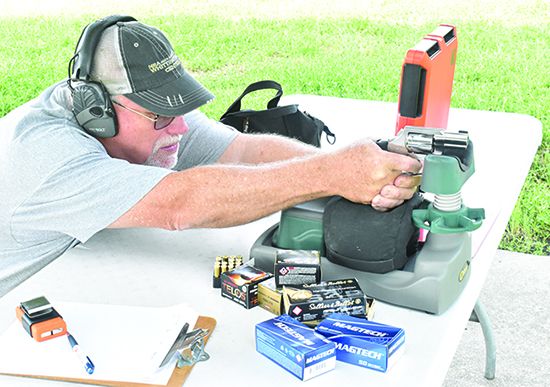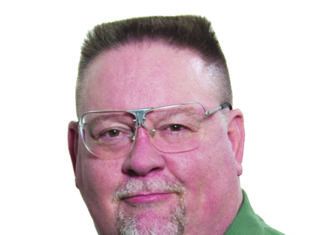Gun Tests readers have been asking us for more revolver testing, so we’ve been looking for new and improved versions of wheelguns to load up and shoot. We recently found a trio of snubnosed handguns that promise power and, perhaps, easier carry that readers might enjoy and perhaps invest in. The first is a collaboration between Lipsey’s and Smith & Wesson — the Model 442 Ultimate Carry, a blued 38 Special version of the current hammerless Airweight model. Lipsey’s is the exclusive distributor, and the current counter price seems to be right at $759, which is MSRP. We also tested another S&W product, the current Model 642 Airweight 103810 in 38 Special, $519. Rated for +P loads, this version also uses an aluminum frame but with stainless steel for the barrel and cylinder to handle the higher pressures of +P cartridges. Stepping up another power level, we got a new Colt King Cobra Carry with the 2-inch barrel, a bright stainless finish, a double-action-only trigger, and rated for 357 Magnum. The KCOBRA-SB2BB model is widely retailing for $949.
Ammo selection was all 38 Special to accommodate the two Smiths, which can’t handle 357 Magnum rounds like the Colt. The 38s included the recently introduced G2R Telos 105-grain monometal load, along with 110-grain Federal Hydra-Shoks, Sellier & Bellot 148-grain wadcutter rounds, and Magtech 158-grain lead roundnose loads to top it all off. Given their operation and the intended use of these revolvers, we fired multiple five-shot groups double action only at 5 yards. We shot the speed drills from low ready with one, two, and three timed rounds at 5 yards, trying to keep all our shots inside the “A zone” of a USPSA cardboard target.
Colt’s Mfg. King Cobra Carry KCOBRA-SB2BB357 Magnum
$949
Gun Tests grade: B+
Slightly larger than the five-shot S&Ws, this six-shot Colt might make a better belt gun than pocket pistol. If weight is not an issue, take a look at the Colt. It was accurate, and we thought the trigger was better than the new Pythons we tested recently.
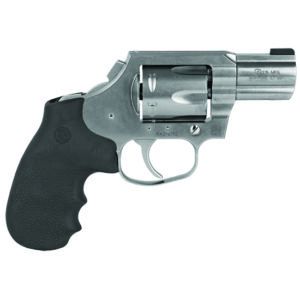
| Action Type | Revolver, double action only |
| Overall Length | 7.25 in. |
| Overall Height | 5.0 in. |
| Maximum Width | 1.4 in. |
| Weight Unloaded | 1.63 lbs. |
| Weight Loaded | 1.84 lbs. |
| Barrel Length | 2.125 in. |
| Barrel Material | Polished stainless steel |
| Frame Material | Polished stainless steel |
| Cylinder Material | Polished stainless steel |
| Grip Front Strap Height | 2.0 in. |
| Grip Back Strap Height | 3.7 in. |
| Grip Thickness (Maximum) | 1.17 in. |
| Grip Circumference | 5.0 in. |
| Capacity | 6 |
| Rear Sight | Fixed groove |
| Front Sight | Fixed blade w/brass bead |
| Sight Radius | 3.4 in. |
| Trigger Pull Weight | 8.5 lbs. |
| Trigger Span | 3.4 in. |
| Safety | Transfer bar |
| Warranty | 1-year non-transferrable |
| Telephone | (800) 241-2485 |
| Website | Colt.com |
| Made In | U.S. |
Colt’s developed its small revolvers at about the same time, for the same uses, and for the same consumers as did Smith & Wesson. However, Colt’s built them to a slightly different formula. Whereas the 38 Special/357 Magnum Smiths are five-shooters, the Colt’s can handle six. There have been any number of people over the decades who thought that one extra shot was necessary.
The new Colt we selected was a double-action-only (DAO) King Cobra Carry. With six chambers and the cylinder to match, the King Cobra was a larger revolver than the S&Ws. Empty weight for the Cobra was almost 10 ounces heavier than the Model 442 UC and 12 ounces heavier than the standard 642. With this model designed to handle up to a 357 Magnum round, we wondered how it compared to a Python. We measured the Python’s cylinder at 1.53 inches and the King Cobra at 1.40 inches, so there was a good bit less meat in the cylinder walls of the KC. One of the things that really did impress us with that comparison was the trigger. We loved the Python’s trigger, which had a DAO-required compression of 9.5 pounds versus the 11.7+ pounds for the snubbie Smiths. Even better, the King Cobra trigger measured a silky 8.5 pounds, with a very smooth pull and very little stacking. The hammer is exposed where one might think it could be captured and cocked to a true single-action position. But that is not the case. There is nothing on the sear that will catch the hammer, making this a true double action only.
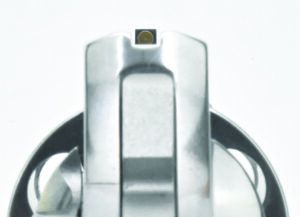
The extra size on the KC brings a couple more advantages. Obviously, the weight is going to help with the stouter loads, though we still can’t say that it was comfortable to shoot with a full-house 357 Magnum load that we fired on the side just to see how it felt. The barrel is a skosh longer, which adds a little more weight out front. The longer barrel and the shroud underneath allow the ejector rod to be longer than on the S&Ws. The difference was marginal, but it was there. The grip frame sports a Hogue Monogrip that permits a full three-fingered grip on the revolver and protects the middle finger well. The overall size of the King Cobra would probably leave it a bit large for pocket carry, even in today’s oversized cargo pockets. That said, it is noticeably smaller than a 2.5-inch-barrel S&W Model 19 K-Frame revolver and should conceal extremely well on a belt. We also like the possibilities this Colt shows as an effective home-defense handgun.
We found the details to be well executed. The edges on the muzzle, barrel underlug, and cylinder have been melted to provide for smoother holstering. The crown has been well recessed to help prevent damage on what can be a roughly-handled carry handgun. The cylinder release was the “pull” type we would expect on a Colt, versus the push-to-activate versions on the Smiths, and the cylinder rotated clockwise versus the counter-clockwise movement on the S&Ws. The 442’s rear sight is a groove milled in the top strap, as with the Model 642 Smith. The front sight is a nice improvement over a standard serrated ramp. The KC uses a blade with a gold bead. Held in place by a set screw above the muzzle, it can be changed out as desired. The net effect was a much more visible sight picture than we had expected.
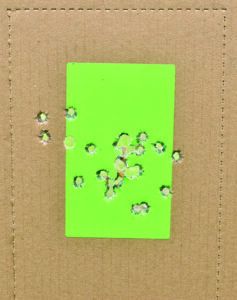
Our Colt King Cobra was quick on target in our first speed drill at 0.89 seconds, though only slightly faster than the 442 UC at 0.93 seconds and the Airweight at 1.06 seconds. The primary advantage for the Colt showed up in accuracy on the A Zone targets, due primarily, we think, to the Colt’s much better trigger. Where the S&W pistols averaged 11.68 pounds of compression to let off (442) and 11.78 pounds (642), the Colt’s trigger was smoother and required less pressure at 8.5 pounds. As a result, the groups were more than 30% smaller, averaging a mere 0.69 inches for best five-shot strings. The 148-grain wadcutters approached a half-inch group average (0.54 inch). In the speed drills, the Colt not only shot all rounds inside the 5-by-11-inch A Zone, but it kept all but two shots in a 3-by-5-inch sticker. Total size was only 4.1 inches.
We trumpet the virtues of the snub-nosed revolver. It is very easy to verify if it is loaded or unloaded, and changing that condition is simple. It doesn’t care if you limp-wrist the shot. It doesn’t care if you put five different kinds of ammo in it. If it doesn’t go bang, all you have to do is press the trigger again. With the very next breath, we tend to call the snubby an expert’s gun. That 12-pound trigger makes an accurate shot more difficult. Not impossible, just more difficult. Those small sights can be hard to see. Effective range can be limited. The shooter needs to learn how to properly manipulate their snubby and learn which hand to use for what operation. For example, do you hold the revolver with the two middle fingers of the support hand protruding through the frame window for reloading? How are you going to reload? How will you carry your reloads? That five- or six-shot cylinder will run out of bullets quickly. That short ejector rod can make removing empties cases an issue, so make sure to hold the revolver muzzle and press the ejector with the support thumb or the shooting hand palm as necessary. These are great little guns, but they do take practice.
Our Team Said: We reiterate that the extra size of the King Cobra Carry can be both an advantage (in offering more grip to hold onto, more weight to counteract muzzle flip, and one more round) and a disadvantage (its larger size makes it more difficult to conceal and heavier to carry). You have to decide which is more important to you.
| 38 SPECIAL RANGE DATA | |||
| G2 Research Telos 105-grain HP | S&W Model 642 | S&W Model 442 UC | Colt King Cobra Carry |
| Average Velocity | 1016 fps | 1015 fps | 1059 fps |
| Muzzle Energy | 241 ft.-lbs. | 240 ft.-lbs. | 261 ft.-lbs. |
| Best Group | 0.751 in. | 0.82 in. | 0.82 in. |
| Average Group | 1.06 in. | 0.86 in. | 0.93 in. |
| Federal Hydra-Shok 110-grain JHP | S&W Model 642 | S&W Model 442 UC | Colt King Cobra Carry |
| Average Velocity | 878 fps | 855 fps | 909 fps |
| Muzzle Energy | 188 ft.-lbs. | 179 ft.-lbs. | 202 ft.-lbs. |
| Best Group | 0.71 in. | 0.85 in. | 0.46 in. |
| Average Group | 0.78 in. | 0.92 in. | 0.66 in. |
| Sellier & Bellot 148-grain Wadcutter | S&W Model 642 | S&W Model 442 UC | Colt King Cobra Carry |
| Average Velocity | 635 fps | 627 fps | 606 fps |
| Muzzle Energy | 132 ft.-lbs. | 129 ft.-lbs. | 121 ft.-lbs. |
| Best Group | 0.67 in. | 0.95 in. | 0.44 in. |
| Average Group | 0.85 in. | 1.06 in. | 0.54 in. |
| Magtech 158-grain LRN | S&W Model 642 | S&W Model 442 UC | Colt King Cobra Carry |
| Average Velocity | 690 fps | 675 fps | 701 fps |
| Muzzle Energy | 167 ft.-lbs. | 160 ft.-lbs. | 173 ft.-lbs. |
| Best Group | 1.23 in. | 1.08 in. | 0.43 in. |
| Average Group | 1.36 in. | 1.21 in. | 0.64 in. |
We fired these revolvers side by side at American Shooting Centers in west Houston. We used a LabRadar chronograph (MyLabRadar.com, $559) to determine muzzle velocities. We used a well-sandbagged Caldwell Pistol Rest from MidwayUSA and a mini-DRC Fortune Cookie bag from Wiebad.com to shoot five-shot groups shot at 5 yards. The Telos is a solid-copper hollow point. JHP = jacketed hollow point. LRN = lead round nose.
| DRILL NO. 1 DATA | |
| Pistol | Single Shot Average Time |
| S&W Model 642 | 1.06 |
| S&W Model 442 UC | 0.93 |
| Colt King Cobra | 0.89 |
Process: Fire one shot from low ready at 5-by-11-inch A Zone target placed at 5 yards. Times in seconds are averages for 10 repetitions.
| DRILL NO. 2 DATA | |||
| Pistol | 1st Shot | Split Average | Total Time |
| S&W Model 642 | 0.97 | 0.43 | 1.4 |
| S&W Model 442 UC | 0.95 | 0.38 | 1.33 |
| Colt King Cobra | 0.887 | 0.333 | 1.22 |
Process: Fire two shots from low ready at 5-by-11-inch A Zone target placed at 5 yards. Times in seconds are averages for three repetitions.
| DRILL NO. 3 DATA | |||
| Pistol | 1st Shot | Split Average | Total Time |
| S&W Model 642 | 0.79 | 0.393 | 1.71 |
| S&W Model 442 UC | 0.917 | 0.348 | 1.61 |
| Colt King Cobra | 0.923 | 0.323 | 1.57 |
Process: Fire three shots from low ready at 5-by-11-inch A Zone target placed at 5 yards. Times in seconds are averages for three repetitions. Elapsed times for all drills were determined using a CED7000 shot timer.
Written and photographed by Joe Woolley, using evaluations from Gun Tests Team members. GT


